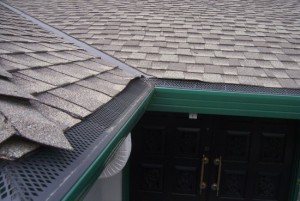
With forecasts calling for heavy rains in 2018-2019, it’s a good idea to get your home ready for a potentially wet winter. Photo: American Ratings Corporation (2018)
Updated October 24, 2018
Citing a phenomenon known as Pineapple Express, climatologists are predicting heavy rainfall for Northern California this winter. Wikipedia defines Pineapple Express as “a meteorological phenomenon characterized by a strong and persistent flow of atmospheric moisture and associated with heavy precipitation from the waters adjacent to the Hawaiian Islands and extending to any location along the Pacific coast of North America.” While it’s uncertain just how much rain this weather pattern will bring, it’s a good idea to prepare your home for a potentially wet winter. Here are some important steps:

To prevent leaks and other moisture-related problems, have your roof professionally inspected every year. Photo: Sure Roofing & Waterproofing (2018)
Schedule a roof inspection. Have a qualified roofer check the condition of your roof and repair any damaged or missing shingles. Likewise, a professional will make sure there’s adequate leak protection in vulnerable spots like skylights, pipes and chimneys.Remember, components like flashings, underlayment and leak barriers are just as crucial as shingles when it comes to guarding against the elements, so consider replacing these while your roof is being serviced.
Make sure your rain gutter and downspout system is ready to flow. A gutter and downspout system is a critical aspect of rain control because it collects water that’s shed off the roof and transports it safely to the ground. However, when a gutter and downspout system isn’t properly maintained, it can lead to a host of harmful problems, including dry rot; premature damage to siding, paint and exterior trim; and even flooding and foundation settlement.

By keeping out leaves and debris, gutter guards reduce the amount of maintenance needed to keep a drainage system functioning properly. Photo: Wildcat Metals (2018)
Prior to the rainy season, you should clear your gutters of debris (the primary culprit of clogs that lead to overflow) and check them for leaks. If you want to minimize maintenance throughout the year, consider installing a gutter guard system, which keeps debris out so you don’t have to. Also, make sure your downspout outlet is pointed away from your home and place a splash block beneath it to help prevent foundation issues.

Protect your home exterior from wet winter weather by touching up damaged paint and sealing gaps in siding and window trim. Photo: IRC All Siding (2018)
Seal your home’s exterior. Even if your roof and rain gutters are functioning properly, lapses like damaged paint and exposed gaps can leave your home susceptible to moisture problems like dry rot. Conduct a thorough inspection of your home’s exterior and take note of areas where paint has started cracking or peeling, as well as gaps in seams, joints and window trim. Perform any needed paint touch-ups and use a high-quality caulking material to seal all gaps. Remember, to provide full moisture protection, all of your home’s siding panels should be primed on all edges, both front and back.
Check your storm drains. Storm drains are commonly used in areas where the landscape conditions pose potential drainage problems. They’re often overlooked, but if a storm drain gets clogged, it can lead to water intrusion issues and even flooding, so make sure yours is clear of debris before the rain starts falling.
To find a Diamond Certified company that can help you prepare your home for winter, visit www.diamondcertified.info.
One Response
Leave a Reply
You must be logged in to post a comment.

We’ve recently moved to an older home so we’re trying to winterize it as much as possible. We checked the gutters but I did not think to check the storm drains. Our roofing inspection is scheduled so hopefully we’ll be all ready for winter this year. Thank you for the post!